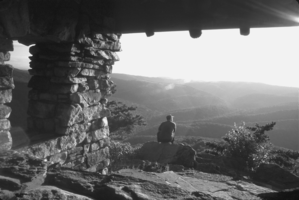 | Back to e-WV
| Back to e-WV
 The West Virginia Encyclopedia
The West Virginia Encyclopedia
 | Back to e-WV
| Back to e-WV
 The West Virginia Encyclopedia
The West Virginia Encyclopedia

West Virginia acquired the land for Lost River State Park in 1933, and the park, with its 3,712 acres in the mountains of Hardy County, opened in 1937. The park is located on tributaries of Lost River, which flows across the county to the Wardensville area. There the Lost River sinks into a mountain; when it returns to the surface on the other side it becomes the Cacapon River.
A park landmark is the Lee Cabin, built in 1804 by Henry ‘‘Lighthorse Harry’’ Lee, a Revolutionary War general and the father of Robert E. Lee. The wealthy Virginia family built the two-story log building as a summer retreat from the heat of their eastern Virginia home. The original foundation has stone blocks so true they look as if they were cut by machine. Antique tools and furniture fill the rooms today. Across the creek lies Lee Sulphur Spring. With its strong taste and smell of sulfur, 19th-century visitors thought the spring water cured many ailments.
Cranny Crow, a rocky escarpment atop Big Ridge Mountain, is the most prominent lookout in the park, popular with hikers and photographers. Hiking trails, both easy and strenuous, wind through the park. The Staghorn and Howards Lick trails provide easy walking on well marked paths. Lost River State Park was built by the Civilian Conservation Corps, whose Camp Hardy was located near the present entrance to the park. Starting in 1934, CCC workers built cabins at Lost River, with porches and field stone fireplaces.
The park now has 26 cabins, five campsites, and other attractions.
Written by Maureen F. Crockett